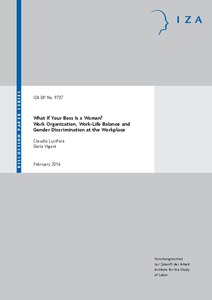What if your boss is a woman? Work organization, work-life balance and gender discrimination at the workplace
"In this paper, we investigate the association between female leadership, work organization practices and perceived gender discrimination within firms. Using data for 30 European countries for the period 1995-2010, we find that having a female "boss" is associated with lower overall g...
| Main Authors: | , |
|---|---|
| Institution: | ETUI-European Trade Union Institute |
| Format: | TEXT |
| Language: | English |
| Published: |
Bonn
2016
IZA |
| Subjects: | |
| Online Access: | https://www.labourline.org/KENTIKA-19106524124919247069-What-if-your-boss-is-a-woman?-.htm |
| Summary: | "In this paper, we investigate the association between female leadership, work organization practices and perceived gender discrimination within firms. Using data for 30 European countries for the period 1995-2010, we find that having a female "boss" is associated with lower overall gender discrimination at work. The female boss effect, however, differs across gender: it is associated with lower discrimination among female employees, but higher among male employees. We also investigate the underlying mechanisms that shape gender discrimination within firms. We find evidence of a "women helping women" pattern through spill-over effects which reduce discrimination among women, but increase discrimination among men, particularly in female-dominated jobs. A better balance between work and life, a supportive work environment and flexible working time, particularly for women in high-skilled jobs, are shown to be effective in reducing gender discrimination. The above findings are robust to a number of specification changes and different sub-populations in our sample. Further, similar results are found when more traditional measures of gender imbalance, such as wages or career prospects, are used. Finally, to account for potential endogeneity and selection, arising from the non-random distribution of females in higher-rank jobs, we jointly estimate the selection process and the discrimination equation, finding support for a causal interpretation of the results." |
|---|---|
| Physical Description: | 38 p. Digital |

